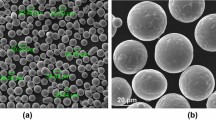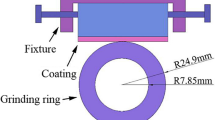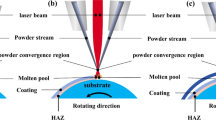Abstract
The development of induction cladding has been restricted by the complicated geometric characteristics of workpieces and the large heat-affected zone in the cladded workpieces. In this paper, three-dimensional continual local induction cladding (3D-CLIC) was proposed as a potential process to clad coating over a substrate with curved surface, and a stationary local induction cladding (SLIC) experiment was conducted as an exploratory study of 3D-CLIC. The microstructures and microhardness in the coatings were measured by SEM, EDS, XRD and microsclerometer, respectively. The results indicate that the coating is metallurgically bonded with the substrate without any defects. A compositional gradient exists in the diffusion transfer belt (DTB), and it decreases with the increase in induction heating time. The coating is mainly composed of (Fe, Ni), CrB, M7C3, Ni3B, Ni3Si and M23C6 (M = Cr, Ni, Fe). Among the carbides, M7C3 presents several morphologies and M23C6 is always attached to the DTB. A special phenomenon of texture was found in the SLIC coatings. The preferred orientation in (200) crystal plane or the restrained orientation in (111) (200) crystal plane becomes more obvious as the scanning speed increases. The maximum average microhardness is 721 HV when the coating is heated for 5 s. The wear loss of different samples increases with increasing induction heating time. The longer heating time would result in higher dilution in the SLIC coatings due to the complete mixing with the substrate, thus leading to the decrease in microhardness and wear loss.









Similar content being viewed by others
References
S. Zhu, Z. Wang, X. Qin, H. Mao, and K. Gao, Theoretical and Experimental Analysis of Two-Pass Spot Continual Induction Hardening of AISI, 1045 Steel, J. Mater. Process. Tech., 2016, 229, p 814–825
K. Gao, X. Qin, Z. Wang, and S. Zhu, Effect of Spot Continual Induction Hardening on the Microstructure of Steels: Comparison between aisi 1045 and 5140 Steels, Mater. Sci. Eng. A, 2016, 651, p 535–547
K. Gao, X. Qin, Z. Wang, S. Zhu, and Z. Gan, Effect of Magnetizer Geometry on the Spot Induction Heating Process, J. Mater. Process. Tech., 2016, 231, p 125–136
G. Hu, H. Meng, and J. Liu, Microstructure and Elevated Temperature Wear Behavior of Induction Melted Fe-Based Composite Coating, Appl. Surf. Sci., 2014, 317, p 378–384
G. Hu, H. Meng, and J. Liu, Friction and Sliding Wear Behavior of Induction Melted FeCrB Metamorphic Alloy Coating, Appl. Surf. Sci., 2014, 308, p 363–371
G. Hu, H. Meng, and J. Liu, Microstructure and Corrosion Resistance of Induction Melted Fe-Based Alloy Coating, Surf. Coat. Technol., 2014, 251, p 300–306
M. Xu, S. Zhu, and H. Ding, Electrical Contact Strengthening of Induction-Clad Ni-40% WC Composite Coatings on 40Cr Substrates, Surf. Coat. Technol., 2015, 279, p 32–38
J.H. Chang, T.H. Liu, J.M. Chou, R.I. Hsieh, and J.L. Lee, Microstructural and Microhardness Characteristics of Induction Melted Nickel-Based Alloys, Mater. Chem. Phys., 2010, 120, p 702–708
J.H. Chang, C.P. Chang, J.M. Chou, R.I. Hsieh, and J.L. Lee, Microstructure and Bonding Behavior on the Interface of an Induction-Melted Ni-Based Alloy Coating and AISI, 4140 Steel Substrate, Surf. Coat. Technol., 2010, 204, p 3173–3181
J.H. Chang, J.M. Chou, R.I. Hsieh, and J.L. Lee, Corrosion Behaviour of Vacuum Induction-Melted Ni-Based Alloy in Sulphuric Acid, Corros. Sci., 2010, 52, p 2323–2330
J.H. Chang, S.K. Tzeng, J.M. Chou, R.I. Hsieh, and J.L. Lee, Effect of Dry Sliding Wear Conditions on a Vacuum Induction Melted Ni Alloy, Wear, 2011, 270, p 294–301
D. Wang, Q. Hu, and X. Zeng, Residual Stress and Cracking Behaviors of Cr13Ni5Si2 Based Composite Coatings Prepared by Laser-Induction Hybrid Cladding, Surf. Coat. Technol., 2015, 274, p 51–59
Y. Huang, X. Zeng, Q. Hu, and S. Zhou, Microstructure and Interface Interaction in Laser Induction Hybrid Cladding of Ni-Based Coating, Appl. Surf. Sci., 2009, 255, p 3940–3945
L.J. Da Silva and A.S.C.M.D. Oliveira, NiCrSiBC Coatings: Effect of Dilution on Microstructure and High Temperature Tribological Behavior, Wear, 2016, 350–351, p 130–140
S.E. Rodil, O. Garcia-Zarco, E. Camps, H. Estrada, M. Lejeune, L. Bourja, and A. Zeinert, Preferential Orientation in Bismuth Thin Films as a Function of Growth Conditions, Thin Solid Films, 2017, 636, p 384–391
S. Wang, H. Li, X. Chen, J. Chi, M. Li, L. Chai, and H. Xu, Improving Microstructure and Wear Resistance of Plasma Clad Fe-Based Alloy Coating by a Mechanical Vibration Technique During Cladding, Mater. Sci. Eng. A, 2010, 528, p 397–401
F. Lu, H. Li, Q. Ji, R. Zeng, S. Wang, J. Chi, M. Li, L. Chai, and H. Xu, Characteristics of the Functionally Graded Coating Fabricated by Plasma Transferred Arc Centrifugal Cladding, Surf. Coat. Technol., 2011, 205, p 4441–4446
E.J. Zoqui, M. Paes, and E. Es-Sadiqi, Macro- and Microstructure Analysis of SSM A356 Produced by Electromagnetic Stirring, J. Mater. Process. Tech., 2002, 120, p 365–373
D. Kesavan and M. Kamaraj, The Microstructure and High Temperature Wear Performance of a Nickel Base Hardfaced Coating, Surf. Coat. Technol., 2010, 204, p 4034–4043
Q. Li, D. Zhang, T. Lei, C. Chen, and W. Chen, Comparison of Laser-Clad and Furnace-Melted Ni-Based Alloy Microstructures, Surf. Coat. Technol., 2001, 137, p 122–135
L. Zhang, B. Liu, H. Yu, and D. Sun, Rapidly Solidified Non-equilibrium Microstructure and Phase Transformation of Plasma Cladding Fe-Based Alloy Coating, Surf. Coat. Technol., 2007, 201, p 5931–5936
C. Yao, J. Huang, P. Zhang, Z. Li, and Y. Wu, Toughening of Fe-Based Laser-Clad Alloy Coating, Appl. Surf. Sci., 2011, 257, p 2184–2192
D. Deschuyteneer, F. Petit, M. Gonon, and F. Cambier, Influence of Large Particle Size—up to 1.2 mm—and Morphology on Wear Resistance in NiCrBSi/WC laser Cladded Composite Coatings, Surf. Coat. Technol., 2017, 311, p 365–373
Author information
Authors and Affiliations
Corresponding author
Rights and permissions
About this article
Cite this article
Chen, X., Qin, X., Gao, K. et al. Microstructural Evolution of NiCrBSi Coatings Fabricated by Stationary Local Induction Cladding. J. of Materi Eng and Perform 27, 2446–2456 (2018). https://doi.org/10.1007/s11665-018-3344-4
Received:
Revised:
Published:
Issue Date:
DOI: https://doi.org/10.1007/s11665-018-3344-4




